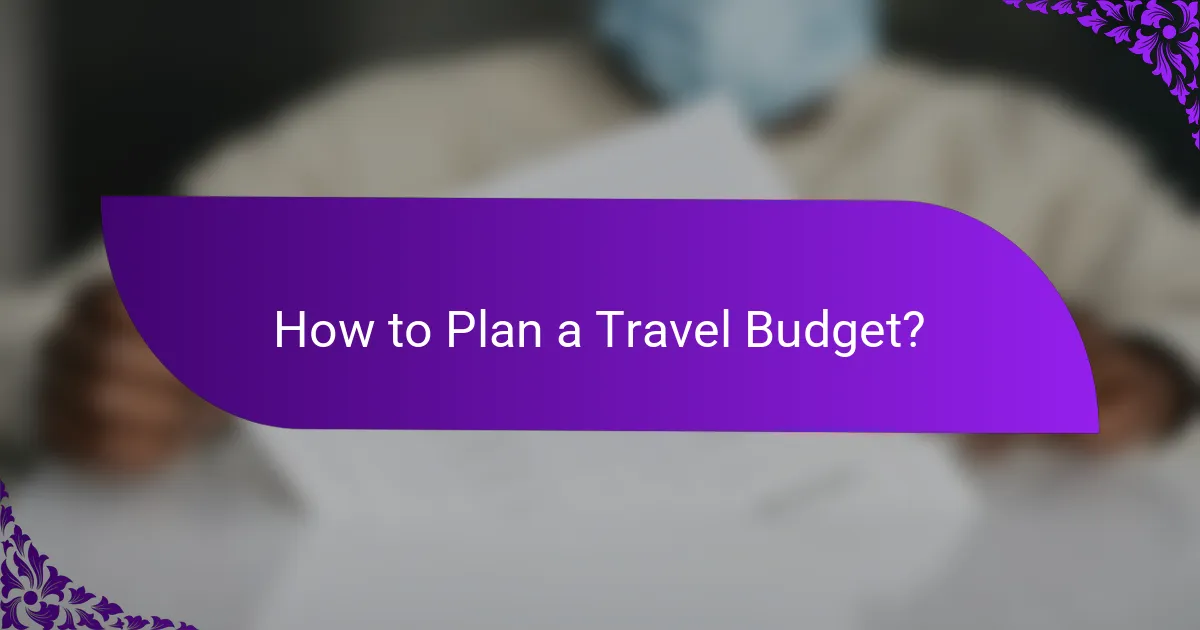Saving for travel requires careful budgeting and planning to ensure a stress-free experience. By estimating your total travel costs, including transportation, accommodation, and activities, you can create a realistic budget that helps you set aside the necessary funds. Implementing effective saving strategies will allow you to achieve your travel goals without straining your finances.

How to Budget for Travel in 2024?
To budget for travel in 2024, start by determining your total travel costs, including transportation, accommodation, food, and activities. Establishing a clear budget will help you save effectively and avoid overspending during your trip.
Set a realistic travel budget
Setting a realistic travel budget involves assessing your financial situation and determining how much you can allocate for your trip. Consider all potential expenses, including flights, lodging, meals, and entertainment, while also factoring in your income and savings goals.
A good rule of thumb is to aim for a budget that covers at least 80% of your expected costs, leaving room for unexpected expenses. This approach helps prevent financial strain while traveling.
Use budgeting apps like Mint
Budgeting apps like Mint can simplify the process of tracking your travel expenses. These apps allow you to set budgets, categorize spending, and monitor your progress in real-time, making it easier to stay on track.
Many of these apps also provide insights into your spending habits, helping you identify areas where you can cut back and save more for your travel plans. Look for features that allow you to set specific travel goals and reminders.
Track expenses with spreadsheets
Using spreadsheets to track your travel expenses offers a customizable approach to budgeting. You can create categories for different spending areas, such as transportation, accommodation, and food, and update it regularly as you plan your trip.
Spreadsheets also allow you to visualize your spending and adjust your budget as needed. Consider using formulas to calculate totals and percentages, which can help you stay within your budget limits.
Allocate funds for emergencies
Allocating funds for emergencies is crucial when budgeting for travel. Set aside a specific amount, ideally around 10-15% of your total budget, to cover unexpected costs such as medical emergencies, trip cancellations, or last-minute changes.
This financial cushion provides peace of mind and ensures that you can handle unforeseen circumstances without derailing your travel plans.
Consider seasonal price fluctuations
Seasonal price fluctuations can significantly impact travel costs. Research the best times to book flights and accommodations, as prices often vary based on demand, holidays, and local events.
For example, traveling during off-peak seasons can lead to substantial savings on flights and hotels. Use fare comparison websites to monitor price trends and set alerts for the best deals.

What Are Effective Travel Saving Tips?
Effective travel saving tips focus on creating a structured approach to set aside funds specifically for your trips. By implementing dedicated strategies, you can accumulate the necessary budget for your travel goals without straining your regular finances.
Open a dedicated savings account
Opening a dedicated savings account for travel can help you keep your travel funds separate from your everyday expenses. Look for accounts that offer no fees and competitive interest rates to maximize your savings. Consider setting a target amount based on your travel plans to motivate you to reach your goal.
Many banks offer online accounts that allow easy transfers and tracking. This visibility can encourage you to contribute regularly, making it less tempting to dip into these funds for non-travel expenses.
Automate monthly savings transfers
Automating monthly savings transfers can simplify your budgeting process and ensure consistent contributions to your travel fund. Set up an automatic transfer from your checking account to your dedicated savings account right after you receive your paycheck.
Even a small amount, such as $50 to $100 per month, can accumulate significantly over time. Review your budget regularly to adjust the amount as your financial situation changes or as you approach your travel goals.
Use travel rewards credit cards
Using travel rewards credit cards can help you earn points or miles for your purchases, which can be redeemed for flights, hotel stays, or other travel-related expenses. Choose a card that aligns with your spending habits and offers generous rewards for categories you frequently use, such as dining or groceries.
Be mindful of interest rates and fees; only use these cards if you can pay off the balance in full each month to avoid accruing debt. Look for sign-up bonuses that can provide a significant boost to your travel savings right from the start.
Participate in cashback programs
Participating in cashback programs can provide additional savings that can be redirected toward your travel fund. Many online retailers and apps offer cashback on purchases, which can add up quickly if you shop through these platforms regularly.
Consider using cashback websites or apps to maximize your savings on everyday purchases. Set a goal to use a portion of your cashback earnings specifically for travel, helping you reach your budget more efficiently.

How to Plan a Travel Budget?
Planning a travel budget involves estimating all potential expenses to ensure you can afford your trip. By carefully considering various cost factors, you can create a realistic budget that allows for enjoyable travel without financial stress.
Research destination costs
Understanding the costs associated with your travel destination is crucial. Research local prices for accommodations, food, transportation, and attractions to get a clear picture of what to expect.
Use online resources, travel forums, and budget travel blogs to gather information. For example, cities in Western Europe may have higher costs compared to Eastern Europe, affecting your overall budget significantly.
Estimate daily expenses
Estimating daily expenses helps you gauge how much money you’ll need each day. Consider factors like meals, transportation, and miscellaneous costs when calculating this figure.
A common approach is to allocate a daily budget based on your destination. For instance, you might budget around $50-$100 per day in Southeast Asia, while in major cities like Paris or London, this could rise to $150-$250.
Include accommodation and transport
Accommodation and transport are often the largest expenses in your travel budget. Research various lodging options, from hotels to hostels, and consider using platforms that offer competitive pricing.
For transport, factor in costs for flights, trains, or rental cars. Booking in advance can often lead to significant savings, so plan accordingly to avoid last-minute price hikes.
Factor in activities and dining
Activities and dining should also be included in your travel budget. Research the costs of attractions you wish to visit and consider whether you’ll dine out or prepare your own meals.
Many destinations offer free or low-cost activities, such as parks or museums on certain days. Budgeting around $30-$70 per day for meals can help you enjoy local cuisine without overspending.

What Are the Best Tools for Travel Planning?
The best tools for travel planning include online platforms that simplify booking flights, accommodations, and activities. Utilizing these tools can save time and money while ensuring a well-organized trip.
Use Google Flights for airfare
Google Flights is a powerful tool for finding and comparing airfare options. It allows users to search for flights based on flexible dates, destinations, and price ranges, making it easier to identify the best deals.
When using Google Flights, consider setting up price alerts for specific routes. This feature notifies you when prices drop, helping you book at the right time. Additionally, explore the “Explore” feature to discover destinations based on your budget.
Explore Airbnb for lodging
Airbnb offers a wide range of lodging options, from private rooms to entire homes, often at competitive prices compared to traditional hotels. This platform allows travelers to filter accommodations based on price, location, and amenities.
When booking through Airbnb, read reviews and check the host’s response rate to ensure a positive experience. Consider booking well in advance, especially during peak travel seasons, to secure the best options.
Check TripAdvisor for activities
TripAdvisor is an excellent resource for discovering activities and attractions at your destination. It features user-generated reviews, ratings, and photos, helping you make informed decisions about what to do.
Utilize TripAdvisor’s “Things to Do” section to find popular tours, local experiences, and hidden gems. Pay attention to seasonal trends and book activities ahead of time to avoid disappointment, especially for popular attractions.
Utilize Skyscanner for comparisons
Skyscanner is a comprehensive travel search engine that compares flights, hotels, and car rentals across various platforms. It helps users find the best prices and options available in one place.
When using Skyscanner, take advantage of its flexible search options, such as searching for the cheapest month to travel. Additionally, consider using the “Everywhere” search feature to discover budget-friendly destinations based on your travel preferences.
